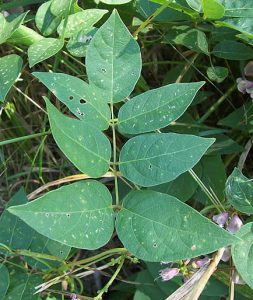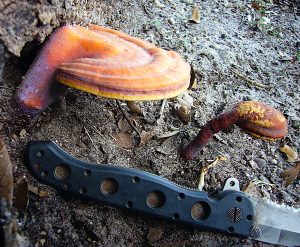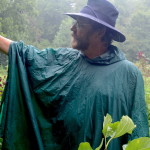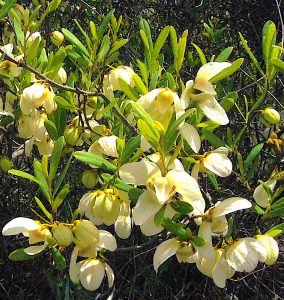
No other root east of the Rockies has the growth pattern of the Groundnut. Photo by Green Deane
The first export from the New World back to Europe was Sassafras wood. It was thought to be medicinal. The second export on any large scale was groundnuts, Apios americana. While gold fever later became a motive early explorations were for plants. John Smith, of Pocahontas fame, made careful botanical notes as he was good friends with the king’s gardener, John Tradescant. In his 909-page book, Florida Ethnobotany, Dr. Daniel Austin references Smith. In at least one case Austin prefers Smith’s observations over 400 years ago over that of a PhD. botanist in the 1930s. Smith incidentally, lived a full and a rather amazing life. You can read a little about him in my article about Spiderworts.

Groundnuts have leaflets of three, five and seven. Photo by Green Deane
We found a young groundnut during our foraging class in Largo last Sunday. No other plant east of the Rockies has a similar root growth pattern making it easy to identify. A legume with lumps on its root, it usually grow to about egg size but can be as large as a potato. It also has up to 26% protein, which is a whopping amount for a root. The University of Louisiana developed a commercial cultivar and it can be bought on the internet if you don’t want to go find it. If folks ate groundnuts some 400 years ago — it was a staple for the natives from Maine to Florida — and it was shipped off to Europe as a food, and has been developed into a cultivar, why aren’t we eating it? Why isn’t it in the grocery stores? The answer is it takes a year to first establish itself. In the fast pace of modern agriculture that does not meet commercial practices. But it’s fine for people who like to grow their own food. You can read about the “lost crop” here.
On the foraging wane now are Stinging Nettles and Chickweed. Both are winter edibles along with Dandelions — which are always sparse — and Pellitory (Cucumber Weed.) The latter is definitely peaking. More warm weather in March should drop its production off significantly. By April one usually can find it only in deep shade. Still in seasons are sow thistles and various mustards. Could can find these species on this site by clicking on ARCHIVE then doing a word search.

Lemon Bacopa left, Water Hyssop right with blossom. Photo by Green Deane
Before I forget it is time to write about Bacopa again. Actually there are two Bacopas locally; Lemon Bacopa and Water Hyssop. They are quite different and perhaps it takes a trained botanical eye to appreciate their similarities which strike me as few. Perhaps their greatest difference is texture. Lemon Bacopa is soft, fuzzy, and crushes easily. Water Hyssop is tough and shiny, resiliant. Lemon Bacopa is aromatic and fruity in flavor, Water Hyssop is just pain bitter. Water Hyssop definitely can help with memory issues, Lemon Bacopa is more iffy on that score. One does not find Lemon Bacopa too often whereas Water Hyssop is nearly everywhere the soil is wet. I have found Lemon Bacopa only three times; two of them in the wet ruts of woods roads. There is also a lake near me that has a little growing near a boat ramp when the water level is just right. As my article speaks more towards Lemon Bacopa I will adress Water Hyssop here. It basically stimulates the brain to make new nerve endings, specifically in the hippocampus. It is anti-inflammatory and interacts with the dopamine and serotenergic systems. As you might expect growing new memory cells enough to notice takes time. So Bacopa has to be taken daily for at least three months. I have had several people tell me it has made significant differences in their lives. It does not work on all causes of memory problems but if it does work it does so dramatically. You can read about both Bacopas here.

Ganoderma curtisii. Photo by Green Deane
When will we be seeing and reading about mushrooms again? The answer is probably after spring rains in April or so. One can find various edible and medicinal mushrooms all year here but April to November is prime time. I harvested several pounds of chanterelles last year. The topic of mushroom came up in the foraging class this week as we saw some Ganodermas starting their seasonal growth. Also known as the medicinal mushroom Reishi, we have several species locally which is a bit of contention. The debate is how many species are there, what are they called, and are they as good as the ones that are sold for medicinal use? As for the latter my herbalist friends say yes, they are as good as the commercial kinds. As for how many and what they are called that probably won’t be settled for decades. I see three, or five, regularly, it’s hard to tell. With certainty I see G. curtisii, G. sessile, and G. zonatum. G. curtisii grows like a short golf club and is the closest relative to G. lingzhi, which is the well-known Chinese Reishi. G. sessile has no stem and grows horizontally (a smaller form is G. sessiliforme.) G. zonatum, more yellow than the rest, is found exclusively on palms and will kill the palm. If your palm has G. zontaum on it there is no hope for it. There is a Ganoderma that grows on citrus and that might have been what we saw this past weekend sprouting on left over citrus roots, G. tuberculosum. To my knowledge none of the Reishis are toxic — but stick to identified species — and local herbalists report good results with them. These mushrooms stimulate the immune system by providing various molecular “keys’ that unlock and turn on immune cells in the gut. By the way I moderated these pages on Facebook: Southeast U.S. Mushroom Identification, Florida Mushroom Identification Forum, Edible Mushrooms: Florida, and Orlando Mushroom Group (which also will start to have meetings and fungal forays as soon as the season turns.)

Classes are held rain or shine or cold…
Foraging Classes: I cross the state this weekend with a class at Haulover Canal on Saturday and one in Port Charlotte Sunday. The bridge at Haulover Canal has reopened allowing us to look at all four quadrants of that historic canal. This class is always conditional in that the federal agency in charge can close the canal, bridge and park at any time for any reason. That is one reason I hold a class there only once or twice a year. Of all the foraging class locations this is the most rustic. The only official bathroom is a Port-O-let, there’s no running water, it is often hot and dusty, and we walk quite a ways. Some classes are an easy stroll. This is a bit more demanding.
Saturday, March 10th, Haulover Canal, Merritt Island National Refuge, north of the Kennedy Space Center. 9 a.m. If northbound go over the bridge, take next left, a dirt road, at the canal turn right, go to west end. Park anywhere. If southbound a quarter of a mile before the bridge turn right onto dirt road, turn right at the canal, go to west end.
Sunday, March 11th, Bayshore Live Oak Park, Bayshore Drive, Port Charlotte. 9 a.m. Meet at the parking lot on Bayshore Drive across from Ganyard Street.
Saturday, March 17th, Blanchard Park, 10501 Jay Blanchard Trail, Orlando, FL 32817. 9 a.m. Meet at the Pavilion east of the tennis courts near the YMCA.
Sunday, March 18th, Dreher Park, 1200 Southern Blvd., West Palm Beach, 33405, 9 a.m. Meet just north of the Science Center in the northern half of the park.
Saturday, March 24th, Florida State College, south campus, 11901 Beach Blvd., Jacksonville, 32246. 9 a.m.We will meet at building “D” next to the administration parking lot.
To read more about the classes or to pre-pay go here.
 Donations to upgrade EatTheWeeds.com and fund a book are going well and is approaching the half way mark. Thank you to all who have contributed to either via the Go Fund Me link, the PayPal donation link or by writing to Green Deane POB 941793 Maitland FL, 32794. Recent upgrades have been paid now the Forum needs work and several function problems need to be fixed specifically the search and categories. A new server also has to be found by April. The other issue is finding an indexing program or function for a real book. Writing programs used to do it automatically if you designated a term for indexing. Now that most books are ebooks most writing programs do not provide and indexing function. The hunt continues.
Donations to upgrade EatTheWeeds.com and fund a book are going well and is approaching the half way mark. Thank you to all who have contributed to either via the Go Fund Me link, the PayPal donation link or by writing to Green Deane POB 941793 Maitland FL, 32794. Recent upgrades have been paid now the Forum needs work and several function problems need to be fixed specifically the search and categories. A new server also has to be found by April. The other issue is finding an indexing program or function for a real book. Writing programs used to do it automatically if you designated a term for indexing. Now that most books are ebooks most writing programs do not provide and indexing function. The hunt continues.

Pawpaws will be blossoming soon. Photo by Green Deane
Pawpaws (or papaws per Random House) can be among the most difficult wild fruits to find. They like to hide and woodland creatures like to eat them making it difficult for us. The easiest way to locate pawpaws is to find them when they’re blossoming. They will be blossoming soon if not already. The most common place to spy pawpaws is and around pastures. Grazing livestock don’t eat the plants, blossoms or fruit. Look for bushy shrubs around five feet tall with magnolia-like cream-colored blossoms, or, much smaller foot-tall shrubs with dark ruby blossoms. I can remember the first time I found a pawpaw. It was along a walking trail in Longwood, Fla. At first I thought I had found a lumpy green pear but it was an unripe pawpaw. Interestingly pawpaws change greatly from hot Florida to the Smoky Mountain area. There, pawpaws are small trees. There are two caveats: A chemical in pawpaws is still used to control head lice. And, some people have a severe allergic reaction when eating them which is the prime reason they have not become a commercial fruit though cultivars have been developed. It’s not a significant health threat to the population at large but it is enough to give the lawyers fits… kind of like inventing peanuts today. To read more about pawpaws, or papaws, click here.

Green Deane DVD Set
All of Green Deane’s videos available for free on You Tube. They do have ads on them so every time you watch a Green Deane video I get a quarter of one cent. Four views, one cent. Not exactly a large money-maker but it helps pays for this newsletter. If you want to see the videos without ads and some in slightly better quality you can order the DVD set. It is nine DVDs with 15 videos on each for a total of 135 videos. Many people want their own copy of the videos or they have a slow service and its easier to order then to watch them on-line. The DVDs make a good gift for that forager you know especially on long, cold winter months. Individual DVDs can also be ordered or you can pick and choose. You can order them by clicking on the button on the top right hand side of this page (if your window is open wide enough.) Or you can go here

Green Deane Forum
Want to identify a plant? Looking for a foraging reference? Do you have a UFO, an Unidentified Flowering Object you want identified? On the Green Deane Forum we chat about foraging all year. And it’s not just about warm-weather plants or just North American flora. Many nations around the world share common weeds so there’s a lot to talk about. There’s also more than weeds. The reference section has information for foraging around the world. There are also articles on food preservation, and forgotten skills from making bows to fermenting food. One special section is “From the Frightening Mail Bag” where we learn from people who eat first then ask questions later. Recent topics include: Cleavers, Five-Petal Yellow Vine, That’s Poor Man’s Pepper, Coconut Purslane Salad, Green Leaves Inner Purple Outline, New Foraging Seasons, Plant’s In Obama’s Portrait, American Nightshade, and What Plant is this? You can join the forum by clicking on “forum” in the menu.
This is weekly issue 294.
If you would like to donate to Eat The Weeds please click here.
 What Do You See 04? (photo above) is a bit of a hodgepodge and a mystery. There are three Oxalis in the picture, and like all Oxalis, all edible. One is native to Florida and the other two come (perhaps) from the Caribbean islands. 1A looks like Oxalis intermedia. It has delta or “butterfly” shaped leaves. Is very tart and has pink blossoms. You can seen the blossom under the upper 1A. 1B also has a pink blossom and looks like O. corymbosa but with several hundred of them the exact identification can be iffy. Also in the picture is the native. 1C, O. stricta which has yellow blossoms (one of which not quite open can be seen above the upper 1A) All of these are tart with oxalic acid. The median lethal does is to eat 12 pounds of these at once. They are quite safe in lesser amount unless you have a family history of calcium kidney stones. THEY ARE NOT CLOVERS. The internet is just plain wrong about that. A clover leaflet is shaped like a T with each little leaf having a short stem. These leaves are equally distributed around a center stem and the leaves themselves do not have stems. They are Oxalises not clovers.#2 is a spiny sow thistle with our two examples at different ages. #3 is the Western Tansy Mustard. It is here only a couple of months in the winter in dry areas. #4 is a Wild Geranium, Cranesbill, very bitter, usually not considered an edible but is medicinal. The mystery plant is #5. The lawn where this was shot has a lot of swine cress in it. And swine cress can sometimes look like this. The blossoms have not opened but will be yellow. The taste right now at this age is non-committal. Besides a possible mustard member it could also be the toxic Senecio glabellus aka Packera glabella. That plant destroys mammalian livers. The leaf arrangement of the S. glabellus is very close to the plant in the picture. And while S. glabellus usually grows in damp spots I have seen it in dry lawn settings. So this would be one to watch. The blossoms when they open will solve the mystery because they are very different between the Senecios and the Mustards. What is irritating is that if you are used to harvesting plants in the mustard family the Senicoes before they blossom can initially trick the eye. They look “mustardy” and are mild in favor (but NEVER eat one… only taste to help in the identification.)
What Do You See 04? (photo above) is a bit of a hodgepodge and a mystery. There are three Oxalis in the picture, and like all Oxalis, all edible. One is native to Florida and the other two come (perhaps) from the Caribbean islands. 1A looks like Oxalis intermedia. It has delta or “butterfly” shaped leaves. Is very tart and has pink blossoms. You can seen the blossom under the upper 1A. 1B also has a pink blossom and looks like O. corymbosa but with several hundred of them the exact identification can be iffy. Also in the picture is the native. 1C, O. stricta which has yellow blossoms (one of which not quite open can be seen above the upper 1A) All of these are tart with oxalic acid. The median lethal does is to eat 12 pounds of these at once. They are quite safe in lesser amount unless you have a family history of calcium kidney stones. THEY ARE NOT CLOVERS. The internet is just plain wrong about that. A clover leaflet is shaped like a T with each little leaf having a short stem. These leaves are equally distributed around a center stem and the leaves themselves do not have stems. They are Oxalises not clovers.#2 is a spiny sow thistle with our two examples at different ages. #3 is the Western Tansy Mustard. It is here only a couple of months in the winter in dry areas. #4 is a Wild Geranium, Cranesbill, very bitter, usually not considered an edible but is medicinal. The mystery plant is #5. The lawn where this was shot has a lot of swine cress in it. And swine cress can sometimes look like this. The blossoms have not opened but will be yellow. The taste right now at this age is non-committal. Besides a possible mustard member it could also be the toxic Senecio glabellus aka Packera glabella. That plant destroys mammalian livers. The leaf arrangement of the S. glabellus is very close to the plant in the picture. And while S. glabellus usually grows in damp spots I have seen it in dry lawn settings. So this would be one to watch. The blossoms when they open will solve the mystery because they are very different between the Senecios and the Mustards. What is irritating is that if you are used to harvesting plants in the mustard family the Senicoes before they blossom can initially trick the eye. They look “mustardy” and are mild in favor (but NEVER eat one… only taste to help in the identification.)
https://www.eattheweeds.com/oxalis-how-to-drown-your-sorrels/
https://www.eattheweeds.com/sonchus-sow-thistle-in-a-pigs-eye-2/
https://www.eattheweeds.com/descurainia-pinnata-abandoned-seed-2/
https://www.eattheweeds.com/erodium-circutarium-geranium-carolinianum-two-bills-you-want-to-get-2/


Thank you for another excellent newsletter Deane!